Numerical Analysis of Magnetic–Fluid–Thermal Multifield Coupling Processes in Electric Fused Magnesia Furnace
Abstract
:1. Introduction
2. Mathematical Models and Boundary Conditions
2.1. Electromagnetic Field Description
2.2. Continuity Equation
2.3. Solidification and Melting Model
2.4. Chemical Reaction
2.5. Physical Model
2.6. Boundary Condition
2.7. Numerical Details
3. Results and Discussion
3.1. Electromagnetic Field Analysis
3.2. Temperature Field Analysis at Starting Stage
3.3. Decomposition Reaction at Starting Stage
3.4. Smelting Stage Analysis
4. Conclusions
Author Contributions
Funding
Data Availability Statement
Conflicts of Interest
References
- Naoi, T.; Lin, H.; Hirota, A.; Otani, E.; Amemiya, K. Improved discharge characteristics using MgO single-crystal particles and advanced CEL structure. J. Soc. Inf. Disp. 2009, 17, 113–119. [Google Scholar] [CrossRef]
- Schroeder, J.L.; Ingason, A.S.; Rosén, J.; Birch, J. Beware of poor-quality MgO substrates: A study of MgO substrate quality and its effect on thin film quality. J. Cryst. Growth 2015, 420, 22–31. [Google Scholar] [CrossRef]
- Malfliet, A.; Lotfian, S.; Scheunis, L.; Petkov, V.; Pandelaers, L.; Jones, P.T.; Blanpain, B. Degradation mechanisms and use of refractory linings in copper production processes: A critical review. J. Eur. Ceram. Soc. 2014, 34, 849–876. [Google Scholar] [CrossRef]
- Ramakrishnan, S.; Koltun, P. Global warming impact of the magnesium produced in China using the Pidgeon process. Resour. Conserv. Recycl. 2014, 42, 49–64. [Google Scholar] [CrossRef]
- Zhao, L.; Feng, J.; Dong, H. Analysis of carbon footprint and reduction approach of magnesia production in China. J. Clean. Prod. 2022, 334, 130194. [Google Scholar] [CrossRef]
- Li, T.; Wang, Z.; Wang, N. Temperature Field Analysis and Process Control Strategies for MgO Single Crystal Production Using Adaptive Neuro-Fuzzy Inference System. Open Mater. Sci. J. 2011, 5, 162–169. [Google Scholar] [CrossRef]
- Fu, Y.; Wang, Z.; Wang, Z.; Wang, N.; Wang, X. Splattering Suppression for a Three-Phase AC Electric Arc Furnace in Fused Magnesia Production Based on Acoustic Signal. IEEE Trans. Ind. Electron. 2017, 64, 4772–4780. [Google Scholar] [CrossRef]
- Wu, Z.; Wu, Y.; Chai, T.; Sun, J. Data-Driven Abnormal Condition Identification and Self-Healing Control System for Fused Magnesium Furnace. IEEE Trans. Ind. Electron. 2015, 62, 1703–1715. [Google Scholar] [CrossRef]
- Qi, G.C.; Shan, F.J.; Li, Q.; Yu, J.Y. Analysis of Fused Magnesia Production Process with 3000kVA Electric Arc Furnace. Appl. Mech. Mater. 2013, 275, 2143–2147. [Google Scholar] [CrossRef]
- Li, J.; Zhang, Y.; Shao, S.; Zhang, S. Comparative life cycle assessment of conventional and new fused magnesia production. J. Clean. Prod. 2015, 91, 170–179. [Google Scholar] [CrossRef]
- Yang, J.; Lu, S.; Wang, L. Fused magnesia manufacturing process: A survey. J. Intell. Manuf. 2020, 31, 327–350. [Google Scholar] [CrossRef]
- Elkoumy, M.M.; El-Anwar, M.; Fathy, A.M.; Megahed, G.M.; El-Mahallawi, I.; Ahmed, H. Simulation of EAF refining stage. Ain Shams Eng. J. 2018, 9, 2781–2793. [Google Scholar] [CrossRef]
- Karalis, K.T.; Karkalos, N.; Cheimarios, N.; Antipas, G.S.; Xenidis, A.; Boudouvis, A.G. A CFD analysis of slag properties, electrode shape and immersion depth effects on electric submerged arc furnace heating in ferronickel processing. Appl. Math. Model. 2016, 40, 9052–9066. [Google Scholar] [CrossRef]
- Halvorsen, S.A.; Olsen, H.A.; Fromreide, M. An efficient simulation method for current and power distribution in 3-phase electrical smelting furnace*. IFAC-PapersOnline 2016, 49, 167–172. [Google Scholar] [CrossRef]
- Florin, D.; Tiberiu, T.; Viegiliu, F. Numerical evaluation of electromagnetic field effects in electric arc furnaces. COMPEL Int. J. Comput. Math. Electr. Electron. Eng. 2001, 20, 619–635. [Google Scholar]
- Kiyoumarsi, A.; Nazari, A.; Ataei, M.; Beheshti, H.K.; Hooshmand, R.A. Electromagnetic analysis of an AC electric arc furnace including the modeling of an AC arc. COMPEL Int. J. Comput. Math. Electr. Electron. Eng. 2010, 29, 667–685. [Google Scholar] [CrossRef]
- Wang, Z.; Wang, N.H.; Li, T.; Cao, Y. 3D Numerical Analysis of the Arc Plasma Behavior in a Submerged DC Electric Arc Furnace for the Production of Fused MgO. Plasma Sci. Technol. 2012, 14, 321–326. [Google Scholar] [CrossRef]
- Wang, Z.; Wang, N.H.; Li, T. Computational analysis of a twin-electrode DC submerged arc furnace for MgO crystal production. J. Mater. Process. Technol. 2011, 211, 388–395. [Google Scholar] [CrossRef]
- Wang, Z.; Fu, Y.; Wang, N.; Feng, L. 3D numerical simulation of electrical arc furnaces for the MgO production. J. Mater. Process. Technol. 2014, 214, 2284–2291. [Google Scholar] [CrossRef]
- Zhang, Y.; Wang, C.; Lu, R. Modeling and monitoring of multimode process based on subspace separation. Chem. Eng. Res. Des. 2013, 91, 831–842. [Google Scholar] [CrossRef]
- Jiang, T.C.; Zhang, W.J.; Liu, S. Performance Evaluation of a Full-Scale Fused Magnesia Furnace for MgO Production Based on Energy and Exergy Analysis. Energies 2022, 15, 214. [Google Scholar] [CrossRef]
- Scheepers, E.; Adema, A.T.; Yang, Y.; Reuter, M.A. The development of a CFD model of a submerged arc furnace for phosphorus production. Miner. Eng. 2006, 19, 1115–1125. [Google Scholar] [CrossRef]
- Zhang, X.K.; He, Y.L.; Tang, S.Z.; Wang, F.L.; Xie, T. An electromagnetics-temperature-component multi-physical coupled model for electric furnace in calcium carbide smelting process. Appl. Therm. Eng. 2020, 165, 114552. [Google Scholar] [CrossRef]
- Logar, V.; Dovžan, D.; Škrjanc, I. Modeling and Validation of an Electric Arc Furnace: Part 2, Thermo-chemistry. ISIJ Int. 2012, 52, 413–423. [Google Scholar] [CrossRef]
- Liu, X.W.; Feng, Y.L.; Li, H.R.; Zhang, P.; Wang, P. Thermal decomposition kinetics of magnesite from thermogravimetric data. J. Therm. Anal. Calorim. 2012, 107, 407–412. [Google Scholar] [CrossRef]
- Tian, L.; Tahmasebi, A.; Yu, J. An experimental study on thermal decomposition behavior of magnesite. J. Therm. Anal. Calorim. 2014, 118, 407–412. [Google Scholar] [CrossRef]
- Longo, G.M.; Longo, S. Thermal decomposition of MgCO3 during the atmospheric entry of micrometeoroids. Int. J. Astrobiol. 2017, 16, 368–378. [Google Scholar] [CrossRef]
- Tesfahunegn, Y.A.; Magnusson, T.; Tangstad, M.; Saevarsdottir, G. Effect of electrode shape on the current distribution in submerged arc furnaces for silicon production—A modelling approach. J. S. Afr. Inst. Min. Metall. 2018, 118, 595–600. [Google Scholar] [CrossRef]
- Tesfahunegn, Y.A.; Magnusson, T.; Tangstad, M.; Saevarsdottir, G. Dynamic Current Distribution in the Electrodes of Submerged Arc Furnace Using Scalar and Vector Potentials. In Proceedings of the ICCS 2018, Wuxi, China, 11–13 June 2018. [Google Scholar]
- Moghadam, M.M.; Seyedein, S.H.; Aboutelebi, M.R. Fluid Flow and Heat Transfer Modeling of AC Arc in Ferrosilicon Submerged Arc Furnace. J. Iron Steel Res. Int. 2010, 17, 14–18. [Google Scholar] [CrossRef]
- Ye, D.; Hu, J. Practical Thermodynamic Data Handbook of Inorganic Substances, 2nd ed.; Metallurgical Industry Press: Beijing, China, 2002; pp. 561–562. [Google Scholar]
- Arkel, A.V.; Flood, E.; Bright, N.F. The electrical conductivity of molten oxides. Can. J. Chem. 1953, 31, 1009–1019. [Google Scholar] [CrossRef] [Green Version]



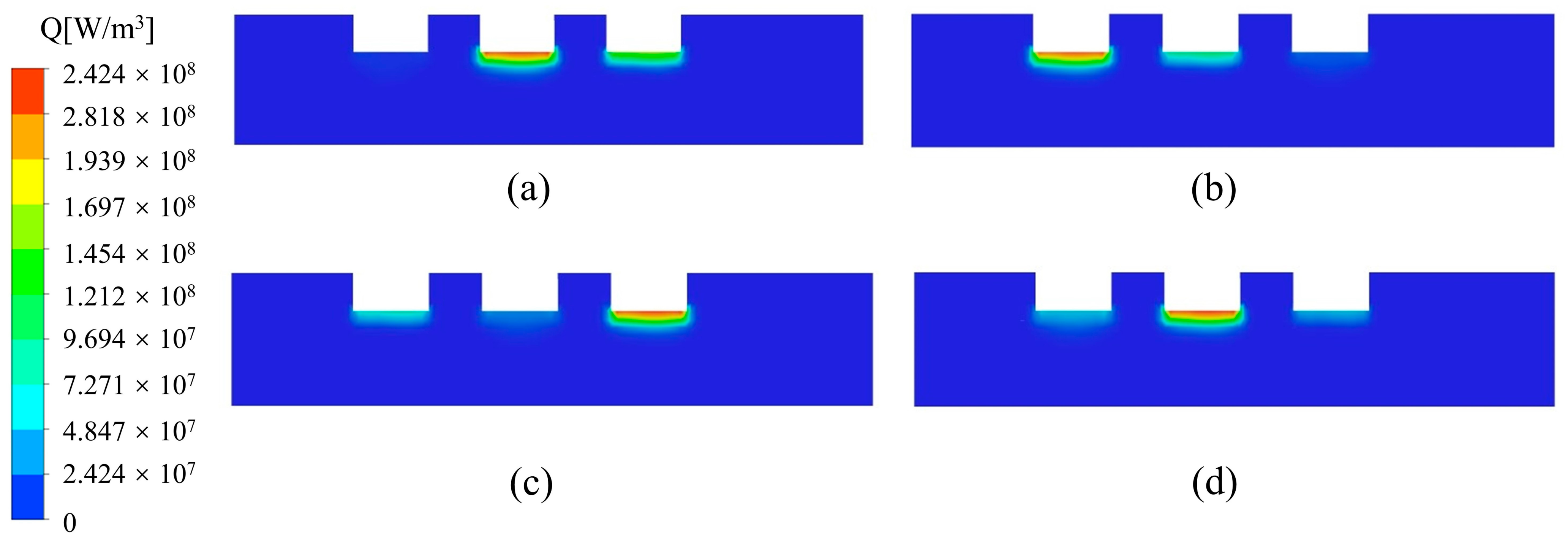
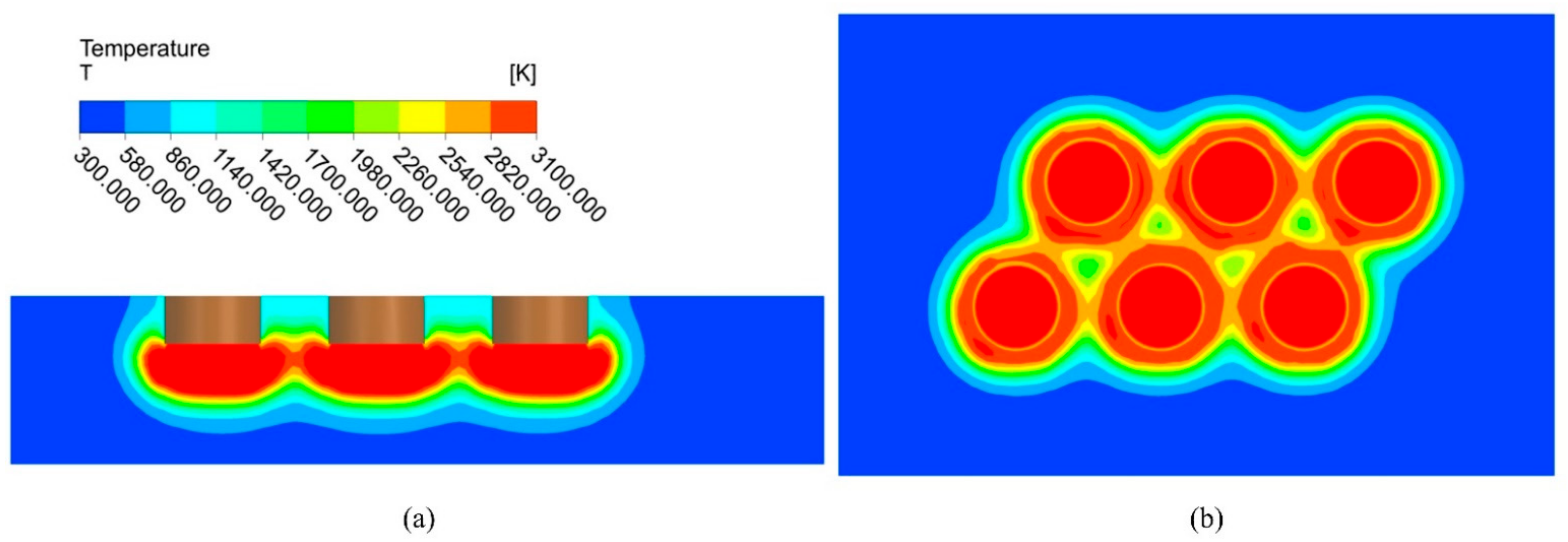
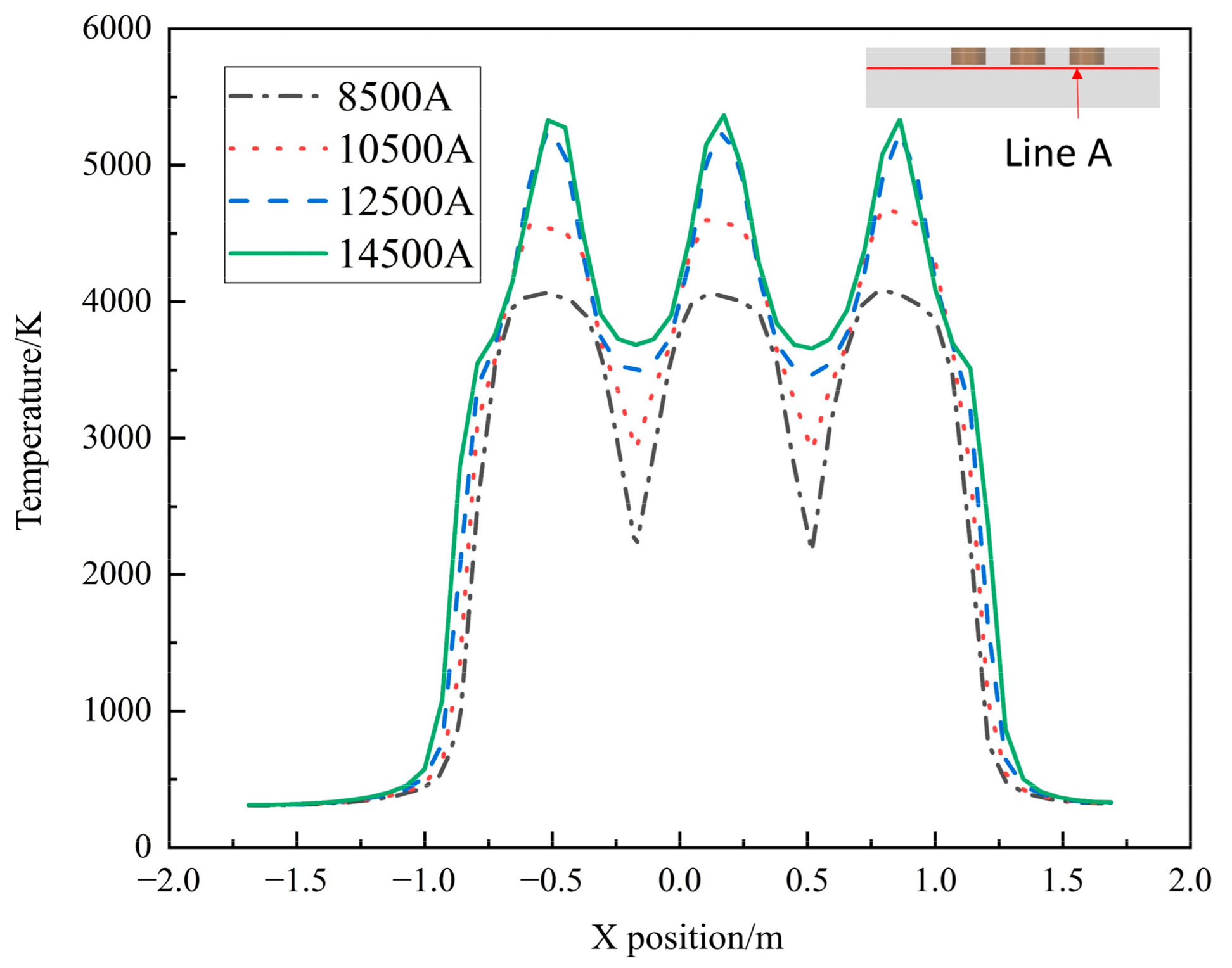



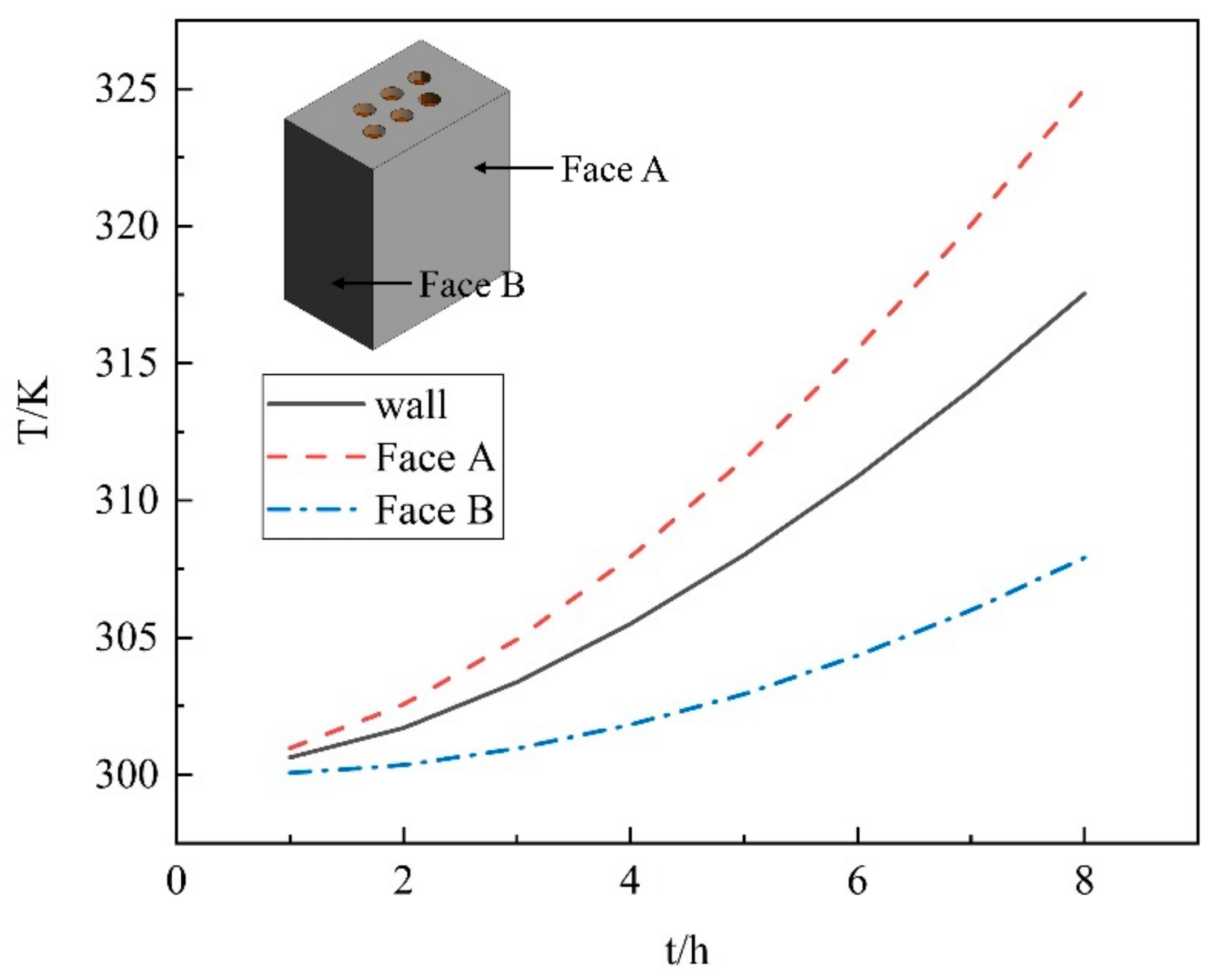
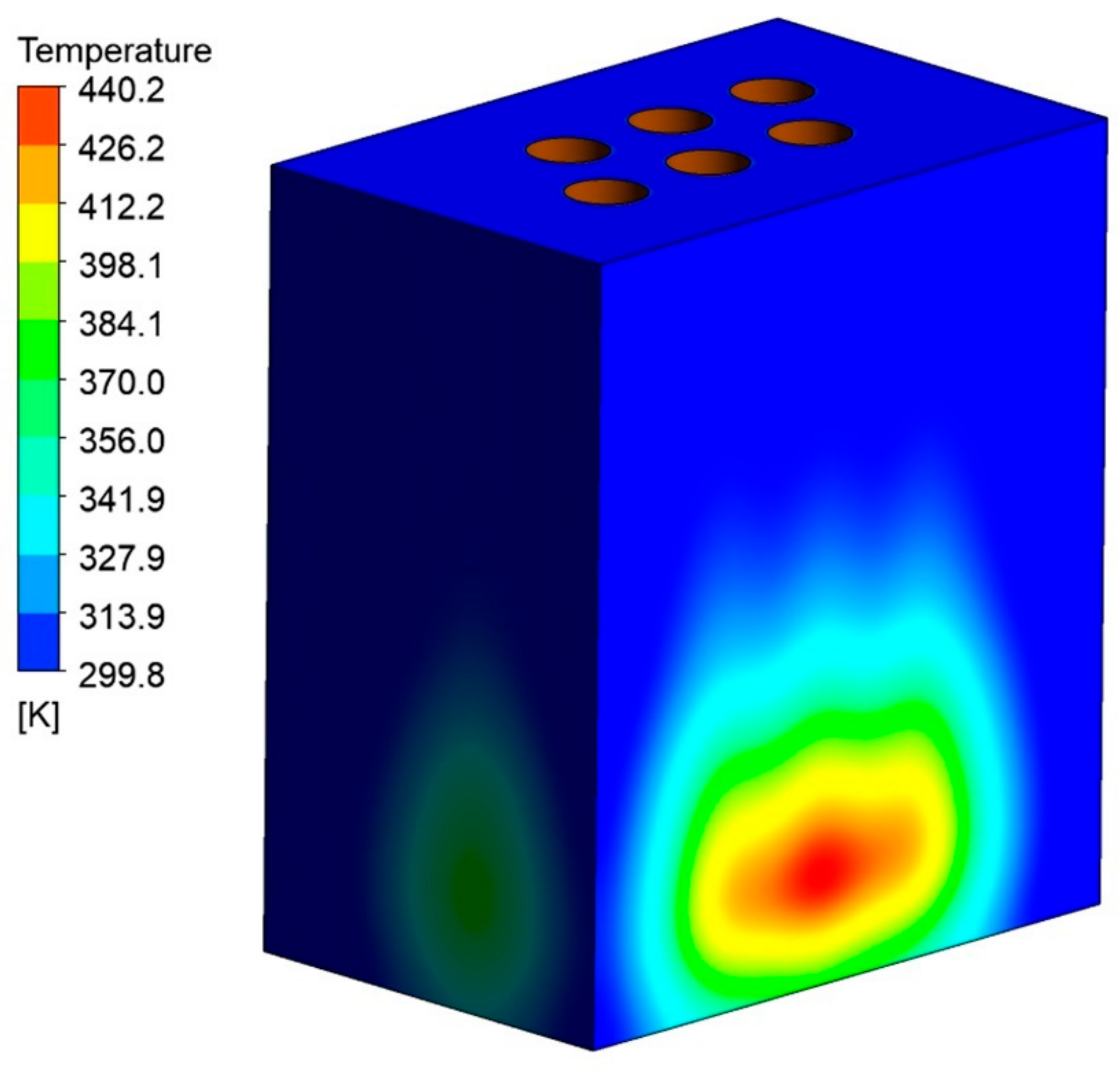
| Property | Parameter (mm) |
|---|---|
| Furnace length l1 | 3400 |
| Furnace height l2 | 700 |
| Furnace width l3 | 2200 |
| Immersion depth h | 200 |
| Electrode diameter d1 | 400 |
| Polar distance l4 | 680 |
| Scalar Potential | Vector Potential | Temperature (K) | |
|---|---|---|---|
| Electrode sidewall | 1000 | ||
| Electrode bottom | Equation (23) | 4000 | |
| Furnace wall | / | ||
| Top surface | / | ||
| Furnace bottom | 0 | / |
Disclaimer/Publisher’s Note: The statements, opinions and data contained in all publications are solely those of the individual author(s) and contributor(s) and not of MDPI and/or the editor(s). MDPI and/or the editor(s) disclaim responsibility for any injury to people or property resulting from any ideas, methods, instructions or products referred to in the content. |
© 2023 by the authors. Licensee MDPI, Basel, Switzerland. This article is an open access article distributed under the terms and conditions of the Creative Commons Attribution (CC BY) license (https://creativecommons.org/licenses/by/4.0/).
Share and Cite
Qi, F.; Hou, Y.; Xu, J.; Li, B. Numerical Analysis of Magnetic–Fluid–Thermal Multifield Coupling Processes in Electric Fused Magnesia Furnace. Processes 2023, 11, 575. https://doi.org/10.3390/pr11020575
Qi F, Hou Y, Xu J, Li B. Numerical Analysis of Magnetic–Fluid–Thermal Multifield Coupling Processes in Electric Fused Magnesia Furnace. Processes. 2023; 11(2):575. https://doi.org/10.3390/pr11020575
Chicago/Turabian StyleQi, Fengsheng, Yunyi Hou, Jianxiang Xu, and Baokuan Li. 2023. "Numerical Analysis of Magnetic–Fluid–Thermal Multifield Coupling Processes in Electric Fused Magnesia Furnace" Processes 11, no. 2: 575. https://doi.org/10.3390/pr11020575




